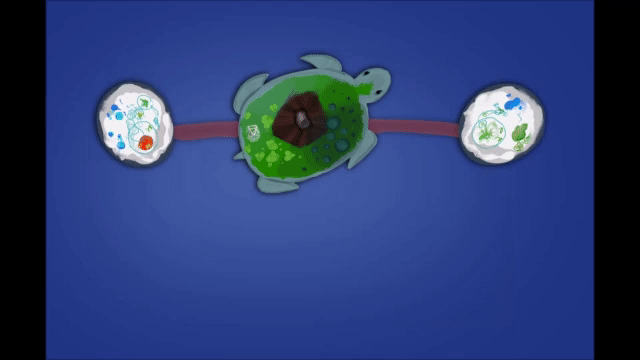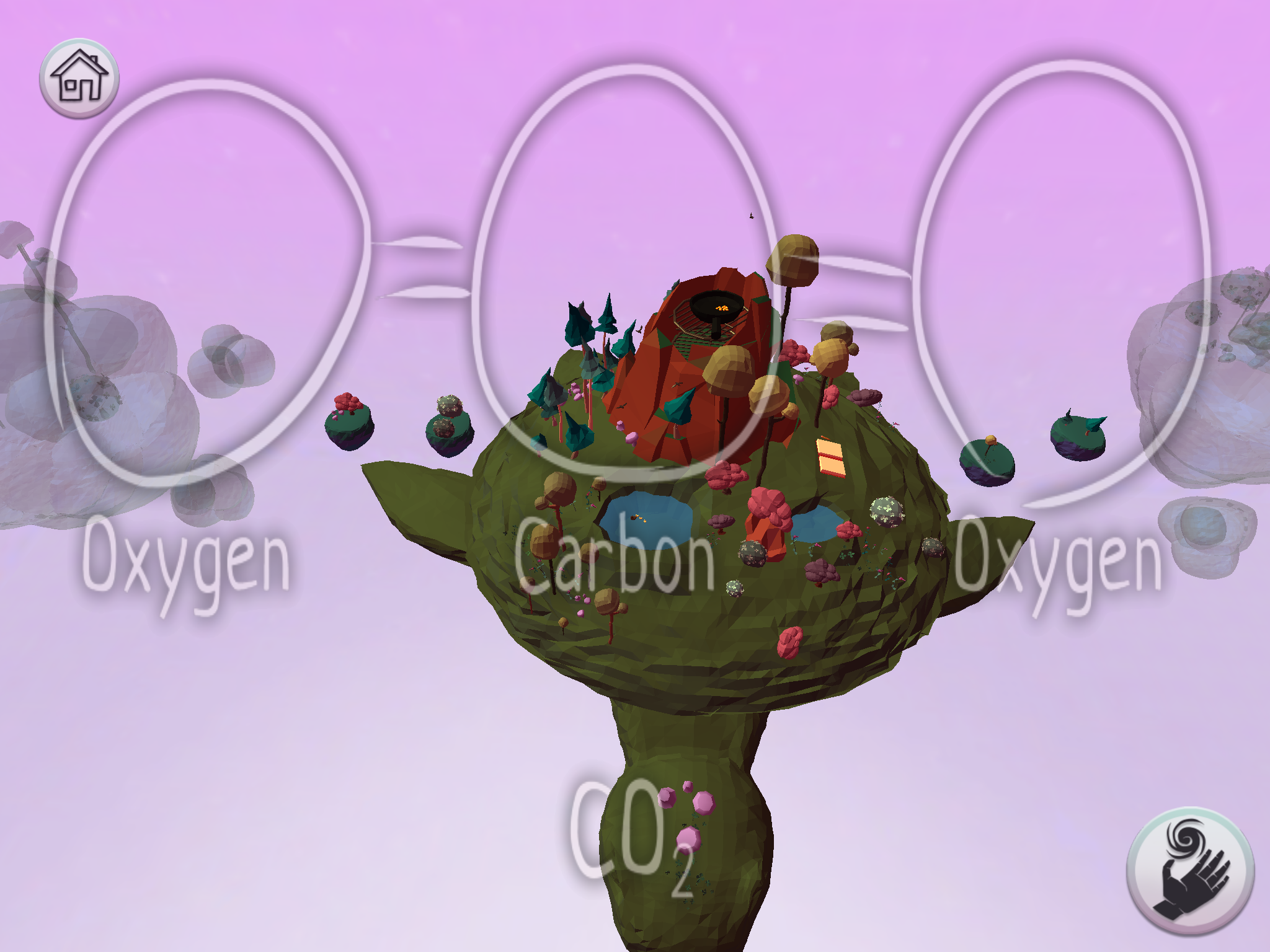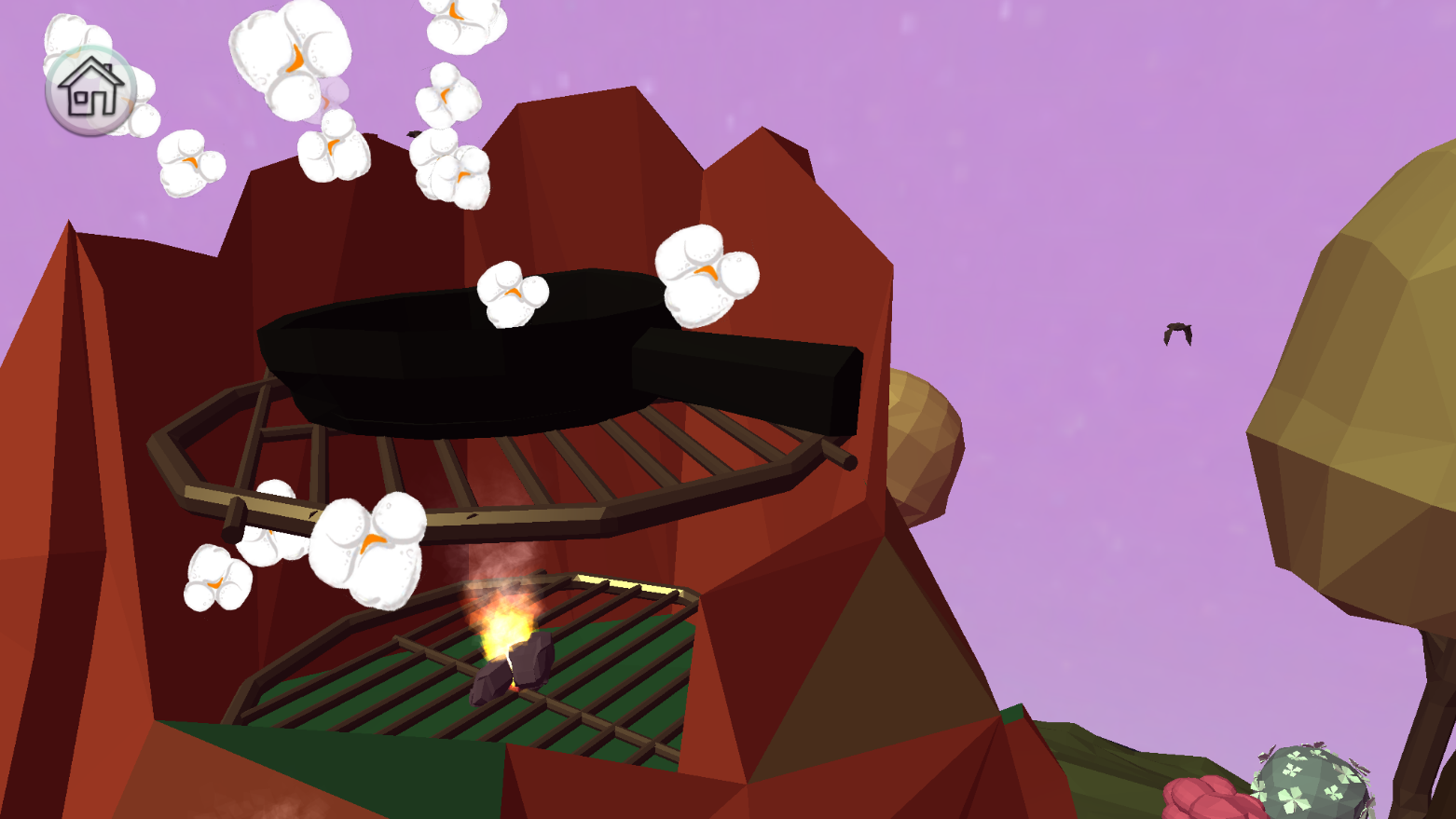One can think of Omnia as Toca Nature meets Grow Cube, while introducing young audiences to atoms and molecules in a charming world of little floating islands. Each island represent an atom, reflecting in its aesthetics the properties of one element from the periodic table. Every island is a condensed little biome, with their own music and life.
These floating islands connect with each other with bridges, simulating chemical bonds. The islands and the puzzles are focused on the properties of one element. In Omnia we have designed puzzle elements to represent basic concepts and chemistry principles, using abstractions and simplifications that are age-appropriate for our target group, and placing them within familiar settings to provide a frame of reference and strengthen associations.
During the development of Omnia we worked in collaboration with 2 chemistry teachers to make sure that, while making children feel like they are wizards crafting their own molecules, we are also teaching them things that are accurate. We want to introduce the basics in a very rewarding and playful way, to help the kids achieve a level of familiarity, before they meet the subject formally at school.
Everything is Chemistry
Chemistry is related to life in general, everything around you, including your own self. Your everyday life items like soap, shampoo, fabric, your breakfast and the pencil you write with.
Understanding chemistry is understanding the building blocks of the Universe, and that is really a wonderful idea. But for many children chemistry is a boring and daunting subject. With Omnia we wanted to challenge that notion.
Developing an imaginative view of chemistry is the key to unlocking its wonders. Capturing the beauty of chemistry and letting the players leap right into the molecular structure to manipulate matter.
Discovering Molecules
Exploring and solving puzzles on the individual islands, allows the players to combine them with other islands, bonding them with each other, and forming new molecules.
As players progress in the game discovering new molecules, they will be able to play with different 18 different elements, combining them and observing the resulting chemical reactions.
We focused on the first 18 elements because the rules for these elements are very straightforward:
Electrons fit nicely into three orbitals (orbitals are the places you will generally find the electrons as they spin around the nucleus).
These eighteen elements make up most of the matter in the Universe.
It's a lot easier to remember facts about 18 elements than over 100 elements.
Design Principles
The aesthetic goal was to keep things organic but minimalistic. Combining simplicity with surprising elements, using colour and character, to create an otherworldly and dream-like landscape.
Learning games need to present failures as a learning opportunity without judgment, punishment, or other negative attributes. With these ideas in mind, Omnia’s gameplay has been designed around exploration and discovery.
The players explore floating islands and solve some simple puzzles applying chemistry principles to find molecular blueprints. These blueprints allow them to manipulate atoms and create their own molecules.
The puzzles can sometimes be solved in more than one way, so that the game rewards the players for coming up with different solutions. Every blueprint is added to the molecular library, and it’s at the disposal of the players to potentially be used later on in another puzzle.
Educational Objectives
Videogames are efficient learning machines that can be used to teach all kinds of things. Good educational games present challenges that target the competence of the players, creating a form of continuous evaluation. Well designed games appeal to internal motivators and fuelling intrinsic motivation enables learning.
The design of Omnia has been influenced by constructivist and experiential learning theories. We have put into practice these theories in combination with game design principles to support learners, age 11 to 13, in their process:
Players influence the context by means of interactivity and by doing so, they feel part of the process.
Good games present challenges that target the competence of the players; games create a form of continuous evaluation.
The players have to master a series of skills by solving the same type of problem before moving up to the next, gradually learning their way up.
Information is offered in-context and when needed, because humans do much better at understanding and remembering information when the application is immediate and the purpose is clear.
All and all, video games are efficient learning machines that can be used to teach all kinds of things.
Project Activities
The main goal for this POC was to produce a vertical slice of an educational game that will allow us to showcase our concept to potential partners and investors. Our focus was on having a short, but polished, portion of the game, including some of the most relevant features.
As project manager I scoped and scheduled tasks accordingly to the team skillset and the time frame we had for development. Keeping track of progress, setting up production processes and, implementing changes when necessary. The team was kept informed about the production schedule, up to date with progress and development targets.
As designer my mission was to keep our group efforts aligned to the high level vision of what the game needed to be. Always making sure that the team was aware of the project vision and on-board with it. Keeping in mind our target audience, designing around the idea of creating a game experience that was engaging, while also effective at conveying basic chemistry principles in such way that knowledge transfer would be possible for the players.
To create a good learning experience, as well as a well designed game, we worked in direct collaboration with two external consultants, a teacher for Chemistry, Physics and Biology for the upper levels of compulsory school in Sweden (Ages 12-16) and a Chemistry teacher for University level in Denmark. This partnership, combined with past experience in designing educational games, was the foundation for a successful experience capable of harnessing the the power of videogames to attract, engage, connect, and teach.
Pre-Production & Prototypes
Exploring Elements: Coal Minigame Prototype
Crafting Coal Minigame
Development Process
Clear high-level vision. We initiated this project with a very straightforward idea of the game we wanted to make, so we were able to jump directly into figuring out how we were going to make it. This gave us the advantage of building a strong foundation for our concept. and being able to properly research many aspects (science, tech, similar products, etc) before going into full production.
Everybody was involved in the pre-production process. It was not difficult to get the team on the same page, as well as keeping them motivated and loving the game we were making.
Alpha & Beta Prototypes
We shaped our initial high level vision into a game concept during several design sprints where, as a producer, I tried to take in consideration technical and time constraints to delineate a development plan.
Several prototypes were produced to test different aspects of the game and start incorporating feedback as early as possible in our process.
Playtesting of our Beta prototype was key to inform our decisions regarding what features were important to implement in order to support the core game design and the goals for the vertical slice.
Crafting Graphite Minigame
Exploring Elements: Graphite Minigame Prototype
One of the most valuable lessons to remember at the beginning of every project is to recognize that game design is an organic process. Clear goals and defined design ideas are a great place to start, but everything changes, goals, intentions, opinions, and, therefor, game designs have to change, too. Embracing this evolving process and adapting to it, is vital, in my opinion, to create successful projects and keep being passionate about them during the development process.

















